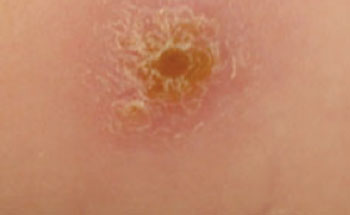Cutaneous Leishmaniasis Successfully Treated with Simple New Therapy
By LabMedica International staff writers
Posted on 10 Dec 2014
A new study has established an initial proof-of-concept that a daylight-activated (DA) form of photodynamic therapy (PDT) constitutes a simple and effective treatment for many cases of cutaneous leishmaniasis (CL). The novel, low-cost method is highly accessible, also for patients in rural and other areas with enough sunlight and lacking the technological infrastructure needed for conventional PDT.Posted on 10 Dec 2014
A team of researchers from the Hadassah Medical Center & University Hospital (Jerusalem, Israel) and the Hebrew University Hadassah Medical School (Jerusalem, Israel), led by Claes Enk, MD, PhD, conducted the study with 31 patients that had been diagnosed with CL, with nonulcerated papulonodular lesions located on anatomical regions easily exposable to daylight: 11 patients with Leishmania major and 20 with L. tropica.

Image: Cutaneous leishmaniasis facial lesion, prior to initiation of successful treatment with daylight-activated photodynamic therapy (DA-PDT) (Photo courtesy of Enk CD et al. 2014, and the British Journal of Dermatology).
The patients were divided into two treatment groups: 14 underwent treatment in the hospital garden under professional supervision and 17 underwent self-administered treatment at home. Lesions were treated, at weekly intervals, by application of a thick layer of 16% methyl-aminolevulinate (MetvixR) and 30 minutes occlusion, followed by exposure to daylight for 2.5 hours. A limited number of control lesions were either treated with cryotherapy (painful, and required multiple liquid-nitrogen applications by healthcare professionals at the hospital) or left untreated. Lesions were monitored using clinical, microbiological, and molecular clearance as outcome measures.
Conventional PDT is time consuming, painful, and expensive, employing an artificial light source requiring healthcare professional use of equipment only available at specialized treatment centers. DA-PDT not only abolishes the need for an artificial light source instrument, but is relatively painless and in this study was also found to enable patients to very effectively self-administer the treatment at home with no professional assistance. The overall cure rate for hospital-based and self-administered DA-PDT was 88.9% (Intention-to-Treat cure rate 77.4%), for the hospital-based treatment group alone 85.7%, and for the self-administered treatment group 92.3%. All the L. major infected patients responded to treatments, whereas 3 of the L. tropica infected patients failed to respond to DA-PDT (L. tropica lesions are known to be generally less benign and more refractory to treatment).
The authors noted that though only a randomized controlled trial can determine the true efficacy of DA-PDT, the present study serves as proof-of concept of a novel self-administered, relatively painless PDT regimen for treatment of CL. Future studies are also needed to optimize the DA-PDT treatment protocol in terms of light doses, treatment frequencies, and penetration of the photosensitizer in larger and in ulcerated lesions. In addition, the use of alternative photosensitizers with better anti-leishmanial activity should be explored, especially for L. tropica infections.
The study, by Enk CD et al., was published in the British Journal of Dermatology, November 1, 2014, online ahead of print.
Related Links:
Hadassah Medical Center & University Hospitals
Hebrew University Hadassah Medical School













